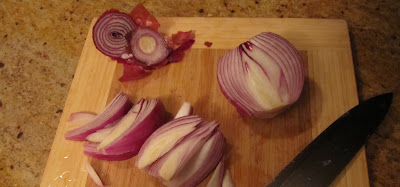This first post is for Dennis, who stopped by with Satya and Bill last night, after a kirtan that marked the end of their six-day tour that took them from Pawtucket to New York City, and finally brought them to Woodstock, New York. Dennis, I'm glad you liked the roasted root vegetables, and yes, it did take me a lot of time to cut them up.
Not as much time as it could have. I learned how to cut vegetables when I worked as kitchen prep at Omega Institute one summer. The trick is to keep the point down and lever the cleaver up and down while proceeding down the carrot. Other vegetables require other motions. But mindful is not slow.
The great thing about roasting vegetables is that you get to play with them from start to finish. First, you can collect all the ones you are going to use in separate piles on the counter. This time of year, I stick to starchy winter root vegetables. Soft summer vegetables off the vine, like zucchini, will cook a lot faster and turn soft, and should not be thrown into the mix with the sturdier roots, which keep their shape.
So, what do you like? Potatoes are great. Rutabagas are similar, and sweeten up with roasting, as do parsnips, carrots, and, to some degree, turnips. Onions and garlic are de rigueur, giving off fragrance as they caramelize. Fennel also falls into this category of heavenly aromas. For extra color, beets are wonderful, though they need to be cut up into smaller pieces, as they take the longest to bake.
And that brings us to the preparation phase, which is also artistic and playful. Most recipes instruct the cook to cut the vegetables into similarly sized pieces, so that they bake evenly. But there's a lot more potential here for fun. If you cut the onions into chunks, they are going to fall apart anyway. So I cut them into thin pie slices off the center, all the way around. The strips will caramelize and darken quite a bit, and that's the enticing undertone for your medley.
Garlic cloves can be thrown in whole, peeled, of course. Potatoes are good as wedges; thinner fry forms may crumble. After I slice the ends off the rutabaga and carve away its heavy, waxed peel, I quarter it. Then I make a row of fairly thin slices along each quarter, producing little fan shapes that turn a lovely golden color and can be eaten like chips.
Be creative with the fennel bulb. Peel the beets and dice them into one-inch squares. Their intense color may call sweet potatoes to mind; but the latter cook in half the time of everything else, stay moist and turn soft. You might throw thick circles of sweet potatoes in halfway through the baking. I've given up on them for this recipe.
Now, coat everything lightly with oil. Then add herbs and spices and mix again.
I've experimented with seasoning each vegetable separately, thinking potatoes need a lot of salt, carrots, which sweeten, none at all. A good all-round seasoning is a little salt and pepper and a good sprinkling of dried rosemary. That's a good savory mix. Lately I've added a pinch of fennel seeds, which produces a sweeter incense and flavor. Sage is another classic for this recipe. So much can be tried.
And now you're ready to cook! How long did it take you to get to this point? Find a teacher, and learn to chop.
You have preheated the oven to 400 degrees. You've hauled out your thickest baking sheets. The oil on the vegetables will mostly keep them from sticking. You can oil the pan, but it's easy to over-oil, and the vegetables will get soggy. And you do want some charring.
Mix all the pieces together, if you haven't already, and spread them on the cookie sheets. You can have two oven racks of vegetables going; I switch their positions halfway through, as the ones on the bottom darken faster.
Pay attention. As they cook, these pieces of vegetables will need to be stirred and, as they get closer to being done, flipped over more than once. You are the creator; watch your pans, watch the onions soften, be careful about the potatoes sticking, and, as everything begins to crisp, decide when enough is enough.
The root vegetables will shrink to half their volume when roasted, but this will not mean that people will eat twice as much. This is dense, comforting, cold-weather food. A little goes a long way; yet it will be hard to stop picking up pieces.
You can make this ahead, as I did, and then reheat it briefly in a 350-degree oven, after the kirtan is over. (If you make this in the summer, try serving the dish cold, in a salad, with vinaigrette dressing.)
Oh, yes. Baking time is approximately one hour. That's a lot of time all told, for one dish. Mindful is not slow, but it's patient.




It was a delicious dinner! Love roasted veggies :)
ReplyDeleteGreat blog! By the time I finished reading the post, I was feeling pretty hungry...very provocative descriptions. :)
ReplyDeleteJai!